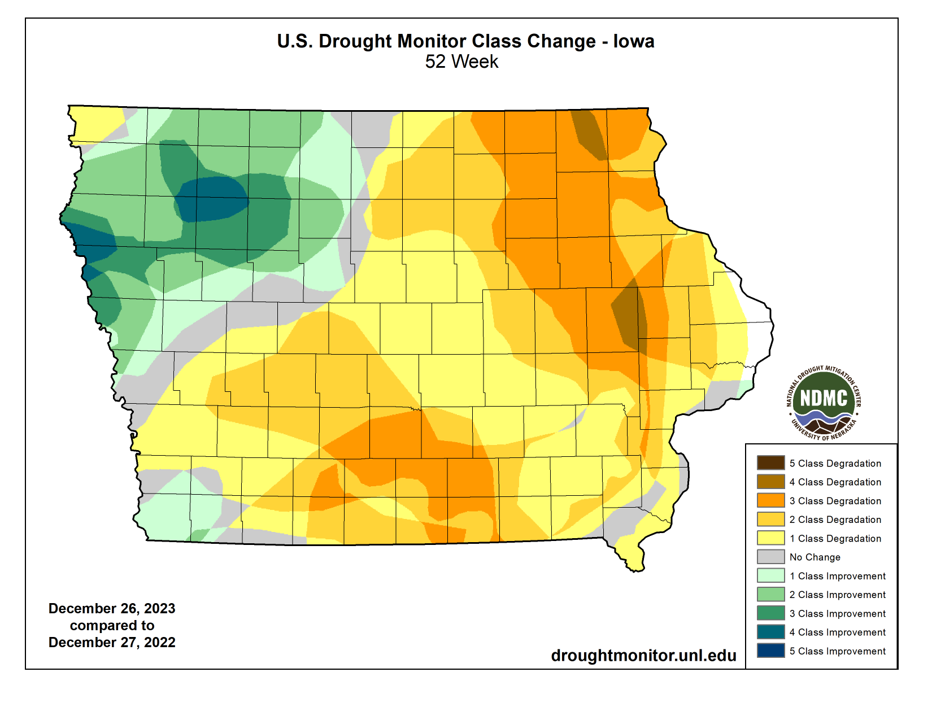A 2023 Iowa weather recap: Drought, tornado outbreaks and massive hail
The National Weather Service Des Moines released a weather recap for 2023: In case you forgot, it was hot and dry last year.
In The Weather Whisper's 2023 Weather Year in Review, NWS lead meteorologist Roger Vachalek wrote that 2023 ended on a mild, and even "quiet" note in Iowa, but that wasn't true all year.
So how did 2023 shape up two of our major climate sites, Des Moines and Waterloo?
In a nutshell ... it was on the warm/hot🌡️🥵 and dry 🏜️ side across the area, which probably doesn't come as much of a surprise. #iawx #climate #byebye2023 pic.twitter.com/ZOSSq03LaF— NWS Des Moines (@NWSDesMoines) January 2, 2024
What type of weather did Iowa experience in 2023?
January 2023 began with a roaring ice storm that impacted portions of northwest Iowa, and later that month northern Iowa saw more than 10 inches of snow.
The 2023 tornado season had the earliest start of any season, dating back to the beginning of tornado records in 1950, Vachalek wrote. In April, we saw more severe events, including hail up to baseball size in central Iowa.
Destructive hail stuck around in May with a heavy storm across central Iowa on May 7. We also saw nearly a dozen tornadoes on May 13.
Database: Track all the tornadoes in Iowa by year
In the summer, we saw notable June storms with large hail and back-to-back straight-line wind storms. In late August, most of the state saw the heat index soar to more than 100 degrees each afternoon.

Through September, October and November drought worsened, and spread across Iowa. This put rivers at record law stages and even endangered drinking water for many communities.
Iowa ended the year with record-breaking warmth in December and more of a tendency for rain, rather than snow. Typically the snowiest month of the year, December fell 6 and a half inches below snowfall averages.
Iowa nears record for longest drought since 1954
Justin Glisan, state climatologist of Iowa, said that we ended 2023 with 182 weeks of consecutive D1 or moderate drought, and we're approaching four years of this drought, the longest we've had since 1954 to 1958. So, we're starting 2024 with long-term precipitation deficits across the state.
"Statewide we're about 80% of normal in terms of the precipitation that we expect," Glisan said. "So what I'm getting at is we're going to need several months, most likely more than a year, of above-average precipitation to really put a dent in the longer-term deficits and start busting the drought."
El Niño likely means warmer winter ahead for Iowa
Iowa sees an El Niño weather pattern — a state where the water temperatures in the Pacific Ocean near the equator become abnormally warm — about every two to seven years. The state is at a moderately strong El Niño with a 54% chance of it becoming historically strong.
Typical winters for moderate or strong El Niño have generally warmer than average temperatures. Since 1950, Iowa has seen seven strong El Niño events.
The average temperature for Iowa in January is 19.5 degrees, and the seasonal temperature outlook for the month shows elevated probabilities of warmer temperatures.
Looking at January, February and March, warmer weather is expected across the upper Midwest, including Iowa. This is a classic El Niño signature in terms of temperature, Glisan said.
Victoria Reyna-Rodriguez is a general assignment reporter for the Register. Reach her at vreynarodriguez@registermedia.com or follow her on Twitter @VictoriaReynaR.
This article originally appeared on Des Moines Register: Iowa 2023 weather recap: Drought, severe storms, early tornadoes

